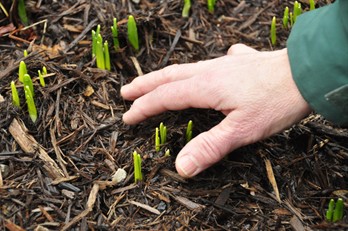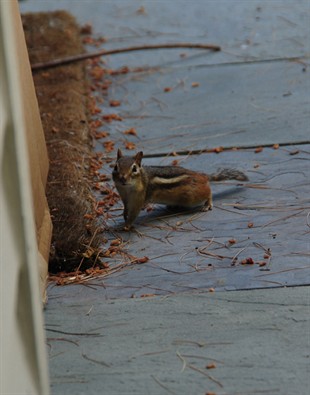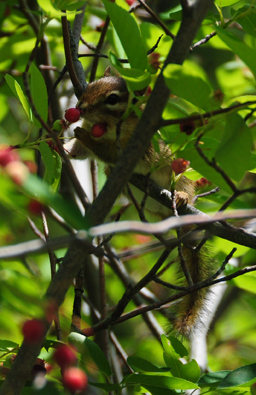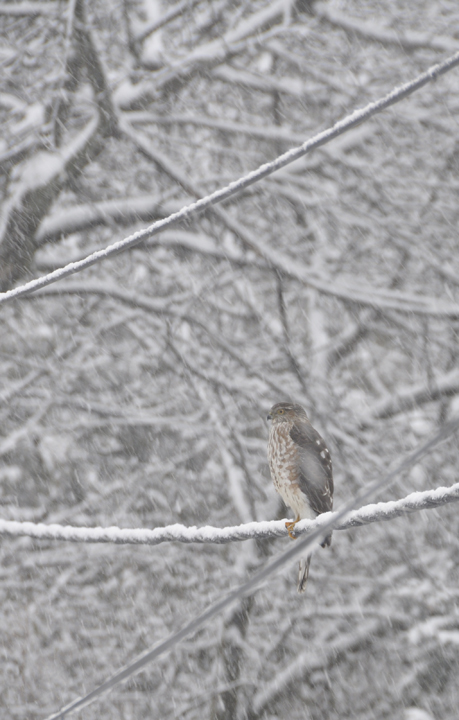Other consequences of warm winter
Dehydration, premature bloom, insect
upsets, rodent romps, well fed birds of prey, spoiled soil and one big question mark!
Ongoing discussion
at the Forum
Water shortage
Dehydration is indirectly related to winter warmup. An evergreen
planted where the soil's dry can dehydrate in a warm winter because
the leaves or needles are photosynthesizing at an unusual rate and
there's none in the soil to replace it. Watering evergreens or
shading them can alleviate this.
Early bloom
Some bulbs may bloom ahead of schedule because, "Well, we are
up, no stopping now." The bloom may last, or not, but that's not a
big blow to the plant. Even if it loses flower, flowering stem and
leaves, it's already benefited from their photosynthesis, may have
more greenery yet to arise from below ground, and has added that to
the starch reserves in its bulb. It'll be back.

Close to the warmth the Earth is always exhaling, these
daffodil leaves will be fine, even though they're up a month early.
Flowers should follow.
For bulbs that keep on coming and bloom early, the story's
different.
See Zoned Out Over Hardiness.
Insect outings
Insects "count hours", often in close step with the plants that
are their hosts. The insect develops inside its egg or pupal case
during every hour when air around it is above 50- or 55°F. Too much
warm weather can result in early emergence. Those that took shelter
under the siding on a building in fall often come out through
interior cracks during winter; if they were human they'd be saying,
"What am I doing up at 3 a.m. and where's breakfast?"
An insect that emerges early in the outdoors, ahead of its food
plants or mates, might freeze or starve. However, it's hard to kill
an insect with cold. We don't even wish for that in most cases,
since early warmth that draws out bugs may also call plants back to
life. Both risk freezing.
Rodent romps
Rodents such as meadow mice (voles) and chipmunks may be more
active in a warm winter. That can mean perennials and grasses lose
more roots and crowns by spring, while woody plants have more bark
chewed, underlying cambium consumed and trunks girdled.
Below, left: Seems to us that chipmunks always look a bit
guilty when they realize we're looking at them!
Recently, B.C. reported spending "...a couple hours on the
nature trails between UM-Dearborn and the Henry Ford Estate... It
was gorgeous. The usual birds. Rabbit, deer, squirrel, mouse and
muskrat tracks. ...I had chipmunks under the bird feeder this
morning. The first chipmunks I've ever seen in Michigan in
January." We, too would comment if we saw a chipmunk in
winter. We've never seen that. Great Uncle Axel told us about one
that tunneled up through deep snow to beg at the back window at his
house in Michigan's Upper Peninsula. But then, he often had snow
into May...
Below, right: Chipmunks like fruit. This one laid claim to a
serviceberry (Amelanchier grandiflora) and
defended it fiercely against all comers, including us. It looks
cute here, stuffing its face with berries, but you'd probably step
back as quickly as we did at its irate charge out along a branch.
We suspect it was a little drunk all through serviceberry season
that year.



Avian feasting
When there is less snow, hawks and owls that hunt rodents may
have easier pickings. Late winter is nesting season for many birds
of prey, and ample food then can mean bigger broods, and healthier
young.
Right: A sharp-shinned hawk posed for Steven as it staked out our
bird feeder. Its fortunes probably change more with local
sparrow populations than temperature, because its diet consists
almost entirely of birds. It'll settle for frogs and we've
seen it perched as here, shredding a garter snake held under one
talon. However, there is another bird of prey that hunts our yard
which might have a different take on the weather. The red tailed
hawk eats rodents and other small mammals, critters that may be
better able to hide under snow than on a bare field.
Did you know that the technical term for the way this bird and
others take prey, by leaping from a stationary postion, is
called lunging? See the rest.
Soil stomps
Wet, ice-free soil gets abused in a winter if people are
accustomed to doing things that put extra weight on it during that
season. Woodlot managers who expect to be able to cut and drag over
frozen ground face harder pulls and create more ruts. Farmers who
cut stubble, spread manure, shift equipment, and tend irrigation
lines face a dilemma: forgo essential work or do it and ruin the
soil, leaving it compacted to the point where it will grow poorly
for years. In conversations overheard last weekend in the
surprisingly lively corn-belt towns of Palestine and Robinson,
Illinois, there was much comment on this fall-out from a warm
winter.
A whirling world
Everything turns on the weather, and everything affects
something else. We can fill out some of the balance sheet when the
pluses and minuses are visible. Meanwhile, me might have no clue or
can guess but not measure weather's impact on bacteria, fungi,
seeds and much more that's pivotal in an ecological system. That is
our world, and yours: the garden, an ecological system so complex
we can each spend a lifetime to learn even the thin layer we can
see.
Isn't it fun!?